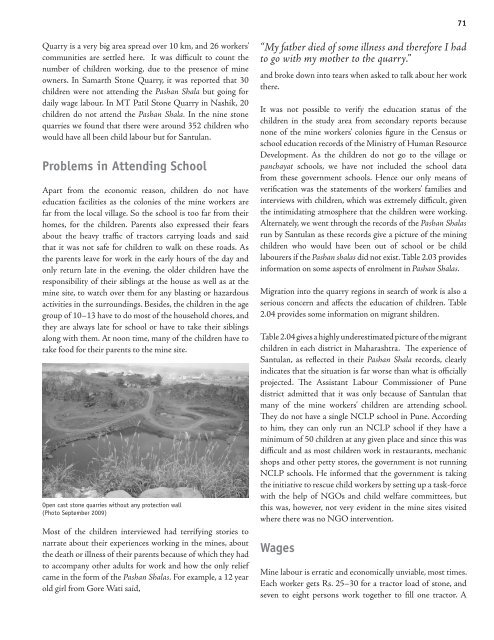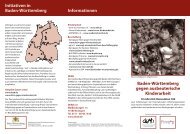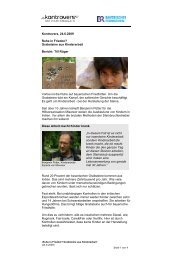Children - Terre des Hommes
Children - Terre des Hommes
Children - Terre des Hommes
You also want an ePaper? Increase the reach of your titles
YUMPU automatically turns print PDFs into web optimized ePapers that Google loves.
71Quarry is a very big area spread over 10 km, and 26 workers’communities are settled here. It was difficult to count thenumber of children working, due to the presence of mineowners. In Samarth Stone Quarry, it was reported that 30children were not attending the Pashan Shala but going fordaily wage labour. In MT Patil Stone Quarry in Nashik, 20children do not attend the Pashan Shala. In the nine stonequarries we found that there were around 352 children whowould have all been child labour but for Santulan.Problems in Attending SchoolApart from the economic reason, children do not haveeducation facilities as the colonies of the mine workers arefar from the local village. So the school is too far from theirhomes, for the children. Parents also expressed their fearsabout the heavy traffic of tractors carrying loads and saidthat it was not safe for children to walk on these roads. Asthe parents leave for work in the early hours of the day andonly return late in the evening, the older children have theresponsibility of their siblings at the house as well as at themine site, to watch over them for any blasting or hazardousactivities in the surroundings. Besi<strong>des</strong>, the children in the agegroup of 10–13 have to do most of the household chores, andthey are always late for school or have to take their siblingsalong with them. At noon time, many of the children have totake food for their parents to the mine site.Open cast stone quarries without any protection wall(Photo September 2009)Most of the children interviewed had terrifying stories tonarrate about their experiences working in the mines, aboutthe death or illness of their parents because of which they hadto accompany other adults for work and how the only reliefcame in the form of the Pashan Shalas. For example, a 12 yearold girl from Gore Wati said,“My father died of some illness and therefore I hadto go with my mother to the quarry.”and broke down into tears when asked to talk about her workthere.It was not possible to verify the education status of thechildren in the study area from secondary reports becausenone of the mine workers’ colonies figure in the Census orschool education records of the Ministry of Human ResourceDevelopment. As the children do not go to the village orpanchayat schools, we have not included the school datafrom these government schools. Hence our only means ofverification was the statements of the workers’ families andinterviews with children, which was extremely difficult, giventhe intimidating atmosphere that the children were working.Alternately, we went through the records of the Pashan Shalasrun by Santulan as these records give a picture of the miningchildren who would have been out of school or be childlabourers if the Pashan shalas did not exist. Table 2.03 provi<strong>des</strong>information on some aspects of enrolment in Pashan Shalas.Migration into the quarry regions in search of work is also aserious concern and affects the education of children. Table2.04 provi<strong>des</strong> some information on migrant shildren.Table 2.04 gives a highly underestimated picture of the migrantchildren in each district in Maharashtra. The experience ofSantulan, as reflected in their Pashan Shala records, clearlyindicates that the situation is far worse than what is officiallyprojected. The Assistant Labour Commissioner of Punedistrict admitted that it was only because of Santulan thatmany of the mine workers’ children are attending school.They do not have a single NCLP school in Pune. Accordingto him, they can only run an NCLP school if they have aminimum of 50 children at any given place and since this wasdifficult and as most children work in restaurants, mechanicshops and other petty stores, the government is not runningNCLP schools. He informed that the government is takingthe initiative to rescue child workers by setting up a task-forcewith the help of NGOs and child welfare committees, butthis was, however, not very evident in the mine sites visitedwhere there was no NGO intervention.WagesMine labour is erratic and economically unviable, most times.Each worker gets Rs. 25–30 for a tractor load of stone, andseven to eight persons work together to fill one tractor. A






